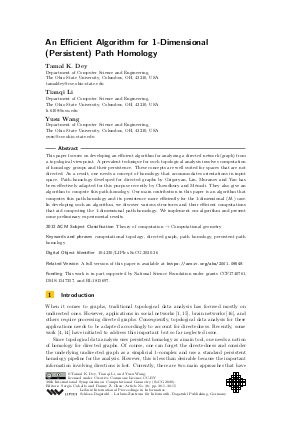An Efficient Algorithm for 1-Dimensional (Persistent) Path Homology
Authors Tamal K. Dey, Tianqi Li, Yusu Wang
-
Part of:
Volume:
36th International Symposium on Computational Geometry (SoCG 2020)
Part of: Series: Leibniz International Proceedings in Informatics (LIPIcs)
Part of: Conference: Symposium on Computational Geometry (SoCG) - License:
 Creative Commons Attribution 3.0 Unported license
Creative Commons Attribution 3.0 Unported license
- Publication Date: 2020-06-08
File

PDF
LIPIcs.SoCG.2020.36.pdf
- Filesize: 0.84 MB
- 15 pages
Document Identifiers
Related Versions
-
A full version of this paper is available at https://arxiv.org/abs/2001.09549.
Subject Classification
ACM Subject Classification
- Theory of computation → Computational geometry
Keywords
- computational topology
- directed graph
- path homology
- persistent path homology
Metrics
- Access Statistics
-
Total Accesses (updated on a weekly basis)
0Document
0Metadata
Abstract
This paper focuses on developing an efficient algorithm for analyzing a directed network (graph) from a topological viewpoint. A prevalent technique for such topological analysis involves computation of homology groups and their persistence. These concepts are well suited for spaces that are not directed. As a result, one needs a concept of homology that accommodates orientations in input space. Path-homology developed for directed graphs by Grigoryan, Lin, Muranov and Yau has been effectively adapted for this purpose recently by Chowdhury and Mémoli. They also give an algorithm to compute this path-homology. Our main contribution in this paper is an algorithm that computes this path-homology and its persistence more efficiently for the 1-dimensional (H₁) case. In developing such an algorithm, we discover various structures and their efficient computations that aid computing the 1-dimensional path-homology. We implement our algorithm and present some preliminary experimental results.
Cite As Get BibTex
Tamal K. Dey, Tianqi Li, and Yusu Wang. An Efficient Algorithm for 1-Dimensional (Persistent) Path Homology. In 36th International Symposium on Computational Geometry (SoCG 2020). Leibniz International Proceedings in Informatics (LIPIcs), Volume 164, pp. 36:1-36:15, Schloss Dagstuhl – Leibniz-Zentrum für Informatik (2020)
https://doi.org/10.4230/LIPIcs.SoCG.2020.36
BibTex
@InProceedings{dey_et_al:LIPIcs.SoCG.2020.36,
author = {Dey, Tamal K. and Li, Tianqi and Wang, Yusu},
title = {{An Efficient Algorithm for 1-Dimensional (Persistent) Path Homology}},
booktitle = {36th International Symposium on Computational Geometry (SoCG 2020)},
pages = {36:1--36:15},
series = {Leibniz International Proceedings in Informatics (LIPIcs)},
ISBN = {978-3-95977-143-6},
ISSN = {1868-8969},
year = {2020},
volume = {164},
editor = {Cabello, Sergio and Chen, Danny Z.},
publisher = {Schloss Dagstuhl -- Leibniz-Zentrum f{\"u}r Informatik},
address = {Dagstuhl, Germany},
URL = {https://drops.dagstuhl.de/entities/document/10.4230/LIPIcs.SoCG.2020.36},
URN = {urn:nbn:de:0030-drops-121944},
doi = {10.4230/LIPIcs.SoCG.2020.36},
annote = {Keywords: computational topology, directed graph, path homology, persistent path homology}
}
Author Details
- Department of Computer Science and Engineering, The Ohio State University, Columbus, OH, 43210, USA
- Department of Computer Science and Engineering, The Ohio State University, Columbus, OH, 43210, USA
Funding
This work is in part supported by National Science Foundation under grants CCF1740761, DMS-1547357, and RI-1815697.
References
-
Wei Chen, Yajun Wang, and Siyu Yang. Efficient influence maximization in social networks. In Proceedings of the 15th ACM SIGKDD international conference on Knowledge discovery and data mining, pages 199-208. ACM, 2009.

-
Ho Yee Cheung, Tsz Chiu Kwok, and Lap Chi Lau. Fast matrix rank algorithms and applications. Journal of the ACM (JACM), 60(5):31, 2013.

-
Norishige Chiba and Takao Nishizeki. Arboricity and subgraph listing algorithms. SIAM Journal on Computing, 14(1):210-223, 1985.

-
Samir Chowdhury and Facundo Mémoli. A functorial dowker theorem and persistent homology of asymmetric networks. Journal of Applied and Computational Topology, 2(1-2):115-175, 2018.

-
Samir Chowdhury and Facundo Mémoli. Persistent path homology of directed networks. In Proceedings of the Twenty-Ninth Annual ACM-SIAM Symposium on Discrete Algorithms, pages 1152-1169. SIAM, 2018.

-
David Cohen-Steiner, Herbert Edelsbrunner, and Dmitriy Morozov. Vines and vineyards by updating persistence in linear time. In Proceedings of the twenty-second annual symposium on Computational geometry, pages 119-126. ACM, 2006.

-
Tamal K Dey, Tianqi Li, and Yusu Wang. Efficient algorithms for computing a minimal homology basis. In Latin American Symposium on Theoretical Informatics, pages 376-398, 2018.

- Pawel Dlotko, Kathryn Hess, Ran Levi, Max Nolte, Michael Reimann, Martina Scolamiero, Katharine Turner, Eilif Muller, and Henry Markram. Topological analysis of the connectome of digital reconstructions of neural microcircuits. arXiv preprint, 2016. URL: http://arxiv.org/abs/1601.01580.
-
Jeff Erickson and Kim Whittlesey. Greedy optimal homotopy and homology generators. In Proceedings of the sixteenth annual ACM-SIAM symposium on Discrete algorithms, pages 1038-1046. Society for Industrial and Applied Mathematics, 2005.

- Alexander Grigor'yan, Yong Lin, Yuri Muranov, and Shing-Tung Yau. Homologies of path complexes and digraphs. arXiv preprint, 2012. URL: http://arxiv.org/abs/1207.2834.
- Alexander Grigor'yan, Yong Lin, Yuri Muranov, and Shing-Tung Yau. Homotopy theory for digraphs. arXiv preprint, 2014. URL: http://arxiv.org/abs/1407.0234.
-
Alexander Grigor’yan, Yong Lin, Yuri Muranov, and Shing-Tung Yau. Cohomology of digraphs and (undirected) graphs. Asian J. Math, 19(5):887-931, 2015.

- F. Harary. Graph Theory. Addison Wesley series in mathematics. Addison-Wesley, 1971. URL: https://books.google.com/books?id=q8OWtwEACAAJ.
-
Paolo Masulli and Alessandro EP Villa. The topology of the directed clique complex as a network invariant. SpringerPlus, 5(1):388, 2016.

-
Ron Milo, Shai Shen-Orr, Shalev Itzkovitz, Nadav Kashtan, Dmitri Chklovskii, and Uri Alon. Network motifs: simple building blocks of complex networks. Science, 298(5594):824-827, 2002.

-
Lav R Varshney, Beth L Chen, Eric Paniagua, David H Hall, and Dmitri B Chklovskii. Structural properties of the caenorhabditis elegans neuronal network. PLoS computational biology, 7(2):e1001066, 2011.

